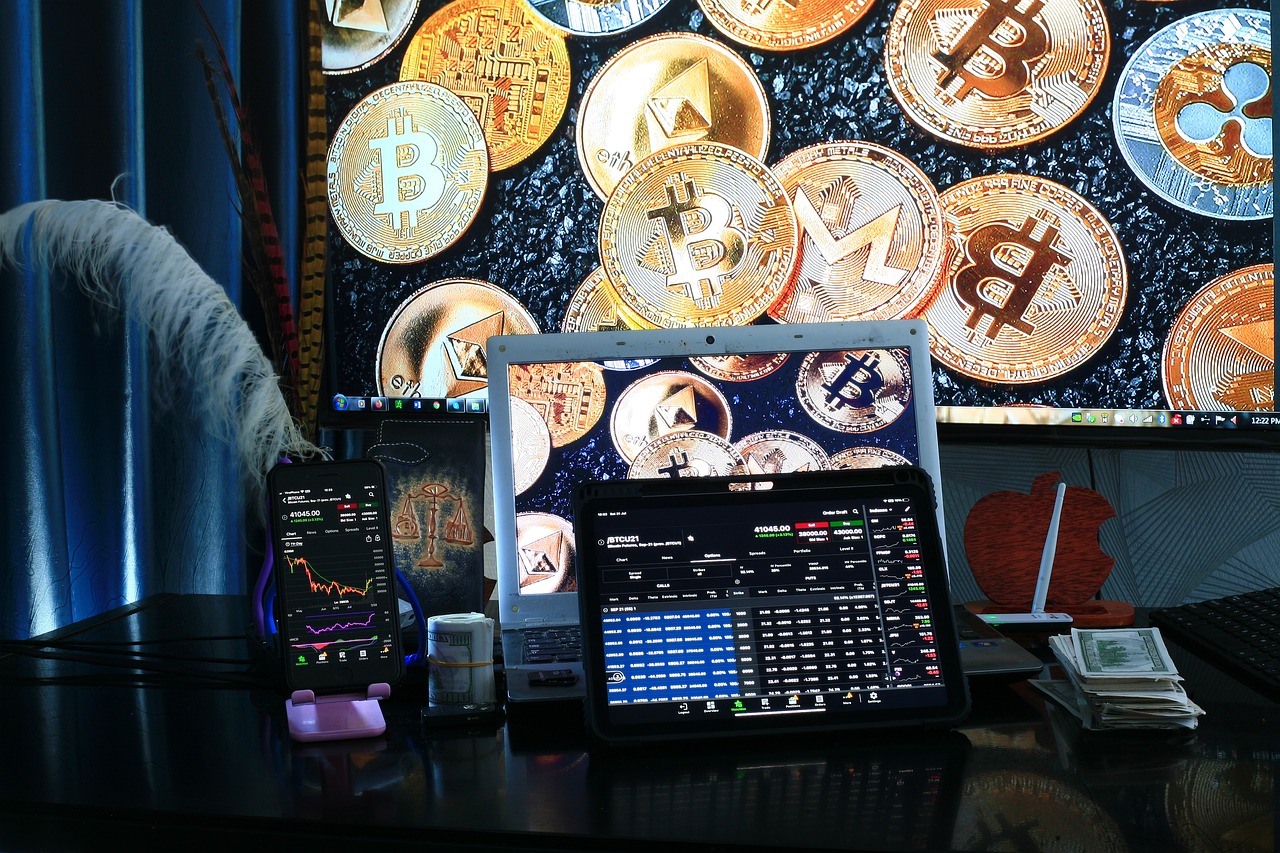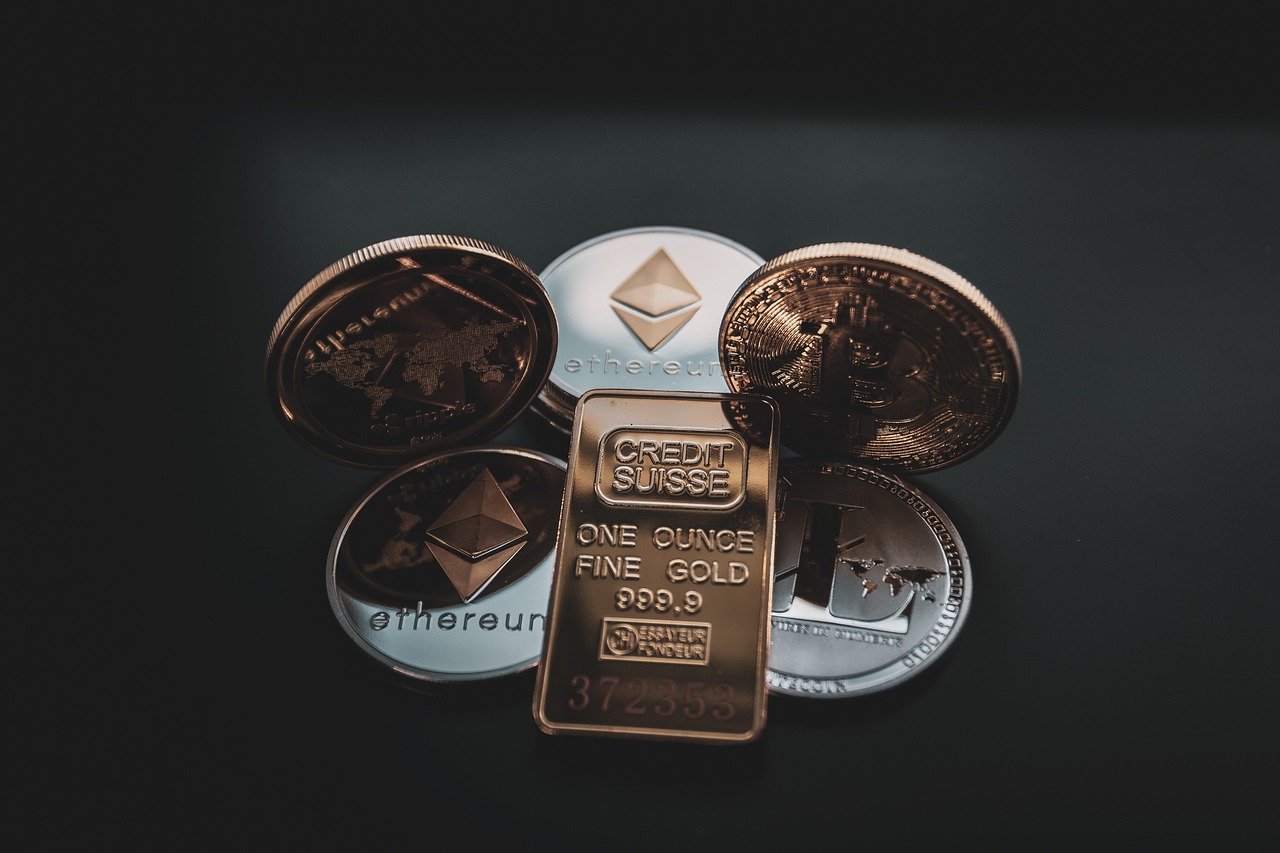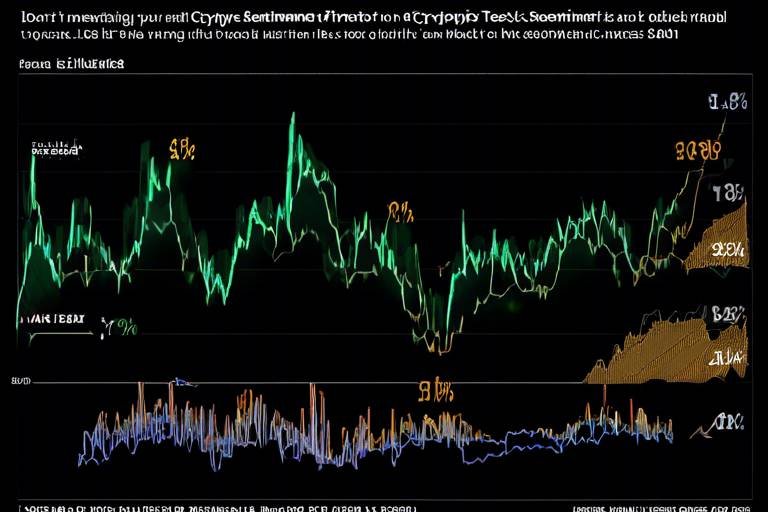How to Safeguard Your Cryptocurrency During Market Crashes
In the ever-evolving world of cryptocurrency, market crashes can feel like a rollercoaster ride—exhilarating yet terrifying. As an investor, you might find yourself clutching your portfolio, heart racing, wondering how to protect your hard-earned assets. Fear not! This article is your roadmap to navigating the turbulent waters of cryptocurrency investment. We'll explore effective strategies that not only shield your investments during downturns but also empower you to emerge stronger on the other side.
Market volatility is the name of the game in the cryptocurrency realm. Prices can soar to dizzying heights one moment and plunge into the abyss the next. But what causes this wild fluctuation? Factors such as regulatory news, technological advancements, and even social media chatter can send prices spiraling. It's crucial to grasp how these elements impact investor behavior. When the market dips, fear often takes the wheel, leading to impulsive decisions. Recognizing this pattern is the first step in implementing protective measures.
Diversification is like a safety net for your investments. By spreading your assets across various cryptocurrencies and traditional investments, you minimize risk and increase your chances of weathering a storm. Imagine you're at a buffet: if you only pile your plate with one dish, you're in for a bland meal. But by sampling different options, you create a feast! In the same vein, a well-diversified portfolio can cushion the blow of market crashes.
When it comes to asset allocation, think of it as crafting a balanced meal. You wouldn’t survive on just protein; you need carbs, fats, and vitamins too. Similarly, distributing your investments wisely can reduce risk exposure during market fluctuations. Here are some techniques to consider:
- Percentage Allocation: Allocate a certain percentage of your portfolio to different cryptocurrencies based on their market stability.
- Risk Assessment: Assess the risk associated with each asset and allocate accordingly, ensuring you have a mix of high and low-risk investments.
Stablecoins are like the calm in the storm. They maintain a stable value, making them a great option during turbulent market conditions. By incorporating stablecoins into your portfolio, you create a buffer against volatility. Think of it as having a safety cushion that preserves your capital while the market swings wildly around you.
Why limit yourself to just cryptocurrencies? Investing across different asset classes—like stocks, bonds, and commodities—can significantly reduce risk. This approach is akin to having multiple streams of income; if one source dries up, you still have others to rely on. By diversifying your investments, you create a more resilient strategy that can withstand market shocks.
Just like you wouldn’t drive a car without checking the fuel gauge, you shouldn’t ignore your investment portfolio. Regularly reviewing your assets is essential for effective risk management. Market conditions change rapidly, and staying on top of your investments allows you to make timely adjustments. Consider setting aside time each month to assess your portfolio's performance and realign your strategy as needed.
In the chaotic world of cryptocurrency, security is paramount, especially during market crashes when scams tend to spike. Protecting your assets is not just about having the right investments; it's also about ensuring they are safe from malicious attacks. Implementing essential security practices can make a world of difference in safeguarding your investments.
Selecting a secure wallet is your first line of defense against potential threats. There are various types of wallets available, each with its pros and cons:
| Wallet Type | Pros | Cons |
|---|---|---|
| Hardware Wallet | Highly secure, offline storage | Costly, less convenient for frequent transactions |
| Software Wallet | User-friendly, accessible | More vulnerable to hacks |
Choosing the right wallet depends on your investment strategy and how often you plan to trade. If security is your top priority, a hardware wallet might be the way to go.
Knowledge is power, especially in the fast-paced world of cryptocurrency. Staying updated on market trends and news can significantly enhance your investment decisions. Follow reliable sources, subscribe to newsletters, and utilize analytical tools. This proactive approach will enable you to make informed choices, even during turbulent times.
- What should I do during a market crash? Diversify your portfolio and consider investing in stablecoins to mitigate risk.
- How often should I review my portfolio? It's advisable to review your portfolio at least once a month to stay aligned with market conditions.
- What type of wallet is best for security? Hardware wallets offer the highest level of security, especially for long-term storage.

Understanding Market Volatility
Market volatility is like a roller coaster ride for investors, especially in the world of cryptocurrency. One moment, prices are soaring to the moon, and the next, they’re plummeting faster than you can say "HODL." So, what exactly causes this wild ride? Various factors contribute to market volatility, including market sentiment, speculation, and even external influences like regulatory news or macroeconomic events. Understanding these elements is crucial for any investor looking to safeguard their assets during turbulent times.
One of the primary drivers of volatility is market sentiment. When investors are feeling optimistic, they tend to buy more, driving prices up. Conversely, fear can lead to panic selling, causing prices to drop sharply. This behavior is often fueled by social media and news outlets, where a single tweet or article can send waves of panic through the market. It’s like a game of telephone, where the message gets distorted, leading to irrational decisions.
Additionally, the cryptocurrency market is still relatively young and less regulated compared to traditional financial markets. This lack of regulation can lead to speculative trading, where traders buy and sell based on short-term trends rather than the underlying value of the assets. This speculation can create significant price swings, as seen during major events like the Bitcoin halving or when a new cryptocurrency is launched. The excitement can lead to a rapid influx of capital, but it can also result in equally swift withdrawals, amplifying volatility.
Another critical aspect to consider is external influences. Global economic conditions, regulatory changes, and technological advancements can all impact market stability. For instance, when a government announces stricter regulations on cryptocurrency exchanges, it can lead to a sudden drop in prices as investors react to the news. Similarly, technological issues, such as network congestion or security breaches, can cause panic and lead to significant price fluctuations.
To navigate this turbulent landscape, investors need to be well-informed and prepared. Understanding the underlying causes of market volatility can help you make more rational decisions rather than emotional ones. It’s essential to develop a strategy that accounts for these fluctuations, allowing you to weather the storm when the market takes a nosedive. Remember, investing in cryptocurrencies is not just about riding the highs; it’s also about managing the lows effectively.

Diversification Strategies
Diversification is not just a buzzword; it's a fundamental strategy that can significantly minimize risk in your cryptocurrency investments. Think of your investment portfolio as a fruit basket. If you only have one type of fruit, like apples, and a sudden frost hits, your entire basket is at risk. However, if you have a variety of fruits—apples, bananas, oranges—you’re more likely to retain some value even if one type suffers. In the world of cryptocurrencies, diversification can help you weather the storm during market downturns.
When it comes to diversification, one of the most effective approaches is to allocate your investments across different cryptocurrencies. This means not putting all your eggs in one basket, or in this case, not investing solely in Bitcoin or Ethereum. Instead, consider exploring a range of altcoins that have different use cases and market behaviors. For instance, you might want to invest in:
- Utility Tokens: These are used within a specific ecosystem and often have practical applications.
- Privacy Coins: Coins like Monero or Zcash focus on anonymity and can attract a different investor base.
- DeFi Tokens: These tokens are part of decentralized finance platforms and can provide unique opportunities for yield farming and liquidity provision.
In addition to diversifying within cryptocurrencies, consider blending in traditional investments like stocks, bonds, and commodities. This cross-asset diversification can create a more resilient investment strategy. For example, when cryptocurrency markets are down, traditional assets may hold their value or even appreciate, providing a safety net for your overall portfolio. It’s like having a sturdy umbrella on a rainy day—you might still get wet, but at least you’re not completely soaked!
To implement effective asset allocation, you might consider the following techniques:
| Asset Class | Percentage Allocation |
|---|---|
| Cryptocurrencies | 40% |
| Stocks | 30% |
| Bonds | 20% |
| Commodities | 10% |
This table is just a starting point; your ideal allocation will depend on your individual risk tolerance and investment goals. As the market evolves, so too should your strategy. Regularly reviewing and adjusting your portfolio will ensure that you are not overly exposed to any single asset class. In essence, diversification is about creating a safety net that allows you to navigate the unpredictable nature of cryptocurrency markets with greater confidence.
In conclusion, embracing a diversified investment approach can be your best defense against market volatility. By spreading your investments across various cryptocurrencies and traditional assets, you can mitigate risks and enhance your chances of long-term success in the crypto space.
What is diversification in cryptocurrency?
Diversification in cryptocurrency refers to the practice of spreading your investments across different cryptocurrencies and asset classes to minimize risk. This approach helps protect your portfolio from the volatility of any single asset.
How can I diversify my cryptocurrency investments?
You can diversify by investing in a mix of cryptocurrencies with different use cases, such as utility tokens, privacy coins, and DeFi tokens, as well as incorporating traditional investments like stocks and bonds.
Why is diversification important during market crashes?
During market crashes, some assets may lose value while others may hold steady or even appreciate. Diversification helps ensure that your overall portfolio remains resilient and reduces the impact of a downturn in any single asset.
How often should I review my diversified portfolio?
It's recommended to review your portfolio at least quarterly or whenever significant market changes occur. This allows you to make necessary adjustments based on performance and market conditions.

Asset Allocation Techniques
When it comes to safeguarding your cryptocurrency investments, asset allocation is your best friend. Think of it as a well-balanced diet for your portfolio—just like your body needs a mix of nutrients to thrive, your investments require a variety of assets to weather the storm of market volatility. By spreading your investments across different cryptocurrencies and even traditional assets, you can significantly reduce your risk exposure. But how do you go about this? Let's break it down.
First off, consider dividing your investments into three main categories: high-risk assets, moderate-risk assets, and low-risk assets. High-risk assets might include newer or less stable cryptocurrencies that could skyrocket in value but also have the potential for steep declines. Moderate-risk assets could be well-established cryptocurrencies like Bitcoin or Ethereum, while low-risk assets might involve stablecoins or even traditional investments like bonds. This tiered approach allows you to take advantage of high-reward opportunities while still having a safety net.
Next, let’s talk numbers. A common rule of thumb is the 60/40 rule, which suggests allocating 60% of your portfolio to high and moderate-risk assets and 40% to low-risk assets. However, this can vary based on your risk tolerance and investment goals. For example, if you’re younger and can afford to take on more risk, you might want to increase your allocation to high-risk assets. On the other hand, if you're nearing retirement, you might lean more towards stablecoins and bonds.
Another effective technique is to use a dynamic allocation strategy. This means you adjust your asset allocation based on market conditions. For instance, during a bullish market, you might want to increase your exposure to high-risk cryptocurrencies, while in a bearish market, you could shift towards stablecoins to preserve capital. This flexibility can be crucial in navigating the unpredictable nature of cryptocurrency markets.
Lastly, don't forget to regularly rebalance your portfolio. This means periodically reviewing your asset allocation and making adjustments as needed to maintain your desired risk level. For example, if one asset class has performed exceptionally well, it might now make up a larger percentage of your portfolio than you intended. Selling off some of that asset and reallocating it to underperforming ones can help keep your investment strategy on track.
In summary, effective asset allocation is not just about where you put your money; it's about creating a strategy that aligns with your financial goals and risk tolerance. By diversifying your investments and regularly reviewing your portfolio, you can better protect yourself during market downturns and position yourself for future growth.
- What is asset allocation?
Asset allocation is the process of distributing your investments among different asset categories such as stocks, bonds, cryptocurrencies, and cash to manage risk and achieve specific financial goals.
- Why is asset allocation important?
Proper asset allocation helps to minimize risk and maximize returns by diversifying your investments, which can protect your portfolio during market fluctuations.
- How often should I rebalance my portfolio?
It’s generally recommended to review your portfolio at least once a year or whenever there are significant changes in the market or in your personal financial situation.
- Can I use automated tools for asset allocation?
Yes, many investment platforms offer automated portfolio management tools that can help you allocate your assets based on your risk tolerance and investment goals.

Investing in Stablecoins
When the cryptocurrency market experiences tumultuous swings, stablecoins emerge as a beacon of stability. These digital currencies are designed to maintain a stable value by pegging them to a reserve of assets, usually a fiat currency like the US dollar. Think of them as the calm in the storm; while others are tossed about by the waves of volatility, stablecoins provide a safe harbor for your investments. By incorporating stablecoins into your portfolio, you can effectively mitigate the risks associated with market downturns.
One of the most appealing aspects of stablecoins is their ability to preserve capital during uncertain times. Imagine you’ve just weathered a market crash and your other cryptocurrencies have taken a hit. By having a portion of your investment in stablecoins, you can quickly convert your volatile assets into a more stable form, allowing you to hold your value without the stress of price fluctuations. This is particularly beneficial during periods of high volatility when panic selling can lead to significant losses.
Moreover, stablecoins can facilitate quick transactions and liquidity. Unlike traditional banks, which can take days to process transfers, stablecoins enable you to move funds swiftly between exchanges or wallets. This agility can be crucial when you spot a buying opportunity during a market dip. With the right stablecoin, you can act fast and secure your investments before the market rebounds.
Here are a few popular stablecoins you might consider:
- Tether (USDT) - The most widely used stablecoin, pegged to the US dollar.
- USD Coin (USDC) - A regulated stablecoin that is also pegged to the US dollar.
- Dai (DAI) - A decentralized stablecoin that is collateralized by other cryptocurrencies.
However, while stablecoins can be a fantastic tool for safeguarding your investments, it’s essential to conduct thorough research before diving in. Not all stablecoins are created equal; some may have less transparency or regulatory oversight than others. Always ensure you’re choosing a stablecoin that aligns with your investment strategy and risk tolerance.
In conclusion, investing in stablecoins can significantly enhance your ability to navigate the choppy waters of cryptocurrency markets. By providing a stable asset to fall back on, they not only help preserve your capital but also offer the liquidity needed to capitalize on market opportunities. So, when the next market crash hits, consider the power of stablecoins to keep your portfolio afloat.
Q1: What are stablecoins?
A1: Stablecoins are cryptocurrencies designed to maintain a stable value, usually by being pegged to a fiat currency or other assets.
Q2: How do stablecoins help during market crashes?
A2: They provide a safe haven for your investments, allowing you to preserve capital and maintain liquidity during volatile market conditions.
Q3: Are all stablecoins safe to invest in?
A3: Not all stablecoins are created equal. It's crucial to research their backing, transparency, and regulatory compliance before investing.
Q4: Can I use stablecoins for transactions?
A4: Yes, stablecoins can be used for transactions, often providing faster and cheaper alternatives to traditional banking systems.

Cross-Asset Diversification
When it comes to investing, the phrase "don't put all your eggs in one basket" rings especially true. is a powerful strategy that allows investors to spread their risk across various asset classes, which can significantly cushion the blow during market downturns. Imagine you’re at a party with a mix of friends, acquaintances, and strangers. If you only talk to one person, you might miss out on a great conversation with someone else. Similarly, by diversifying across different asset classes, you open yourself up to a broader range of opportunities and reduce the impact of a single asset's poor performance on your overall portfolio.
So, what exactly does cross-asset diversification entail? Essentially, it involves investing in a variety of asset classes, such as cryptocurrencies, stocks, bonds, and commodities. Each of these classes behaves differently under various market conditions, which means that when one is down, another might be up. For instance, while cryptocurrencies are known for their volatility, traditional stocks may offer more stability. By blending these assets, you can create a more balanced and resilient investment strategy.
Here’s a quick overview of some asset classes you might consider for cross-asset diversification:
- Cryptocurrencies: High-risk, high-reward assets that can experience significant price swings.
- Stocks: Ownership in companies that can provide dividends and capital appreciation.
- Bonds: Fixed-income securities that can offer stability and predictable returns.
- Commodities: Physical goods like gold and oil that can act as a hedge against inflation.
By incorporating these different asset classes into your investment portfolio, you can achieve a more balanced risk profile. For example, during a cryptocurrency market crash, stocks might hold their ground or even thrive, helping to offset losses from your digital assets. This interplay between asset classes can be likened to a well-orchestrated symphony where each instrument plays a vital role in creating harmony. When one instrument falters, others can step in to maintain the overall balance.
Moreover, cross-asset diversification is not just about mixing asset classes; it’s also about understanding the correlation between them. Some assets may move in tandem, while others may have an inverse relationship. For example, when stocks are down, gold often shines as a safe haven. By analyzing these correlations, you can fine-tune your portfolio to maximize returns while minimizing risk. This strategic approach is akin to being a skilled chef who knows how to balance flavors for the perfect dish—too much of one ingredient can spoil the meal!
In conclusion, cross-asset diversification is a vital strategy for any investor looking to safeguard their portfolio against market crashes. By spreading investments across various asset classes, you can create a more resilient financial foundation. Remember, the key to successful investing is not just about picking the right assets but also about knowing how to blend them effectively to weather any storm.

Regular Portfolio Review
When it comes to investing in cryptocurrency, regular portfolio reviews are not just a good practice; they are essential for safeguarding your investments. Think of your portfolio as a garden that requires regular tending to flourish. Just like plants need the right conditions to grow, your investments need to be nurtured and evaluated consistently to thrive in the ever-changing market landscape.
Market conditions can shift overnight, and what seemed like a solid investment yesterday may not hold the same promise today. By reviewing your portfolio regularly, you can make informed decisions based on current trends rather than past performance. This proactive approach allows you to identify underperforming assets and make adjustments before they drag down your overall returns.
So, how often should you conduct a portfolio review? While it may vary based on individual investment strategies, a good rule of thumb is to review your portfolio at least quarterly. During these reviews, you should assess the following:
- Performance Analysis: Evaluate how each asset in your portfolio has performed over the review period. Are there any cryptocurrencies that have consistently underperformed?
- Market Trends: Stay updated on market trends and news that could impact your investments. For instance, regulatory changes or technological advancements can significantly affect certain cryptocurrencies.
- Risk Assessment: Reassess your risk tolerance. Has your financial situation changed? If so, you might need to adjust your portfolio to align with your current risk appetite.
Additionally, it's crucial to set specific goals for your portfolio. Are you investing for the short-term or long-term? Your investment horizon will dictate how you allocate your assets and which cryptocurrencies to hold. For example, if you're looking for short-term gains, you may want to focus on more volatile assets. However, if your goal is long-term wealth accumulation, consider a more stable approach.
Another aspect to consider during your review is diversification. A well-diversified portfolio can help mitigate risks associated with market downturns. Ensure that your investments span across various sectors and asset classes. This not only reduces risk but also positions you to capitalize on opportunities as they arise.
In summary, a is a cornerstone of effective risk management in cryptocurrency investing. By staying vigilant and making necessary adjustments, you can navigate the turbulent waters of the crypto market with confidence and poise. Remember, it’s not just about riding the waves; it’s about steering your ship in the right direction.
- How often should I review my cryptocurrency portfolio? It's advisable to review your portfolio at least quarterly to stay aligned with market trends and your investment goals.
- What should I focus on during a portfolio review? Evaluate performance, assess market trends, and conduct a risk assessment based on your current financial situation.
- Is diversification really necessary? Yes, diversification helps mitigate risks and positions you to take advantage of various market opportunities.

Implementing Security Measures
In the unpredictable world of cryptocurrency, safeguarding your assets is not just an option; it's a necessity. With the market's inherent volatility, the risk of scams and cyberattacks tends to increase, particularly during market downturns. Therefore, implementing robust security measures is crucial to protect your investments. Think of your cryptocurrency as a treasure chest; without the right locks and guards, it could easily be raided by thieves. So, how do you fortify your treasure chest?
First and foremost, choosing the right wallet is essential. There are several types of wallets available, each with its own advantages and disadvantages. Hardware wallets are often considered the safest option, as they store your private keys offline, making them virtually immune to online hacks. On the other hand, software wallets are more convenient for quick transactions but can be vulnerable to malware and phishing attacks. When selecting a wallet, consider factors such as ease of use, security features, and whether you plan to hold your assets long-term or trade frequently.
Next, you should adopt safe trading habits. Always enable two-factor authentication (2FA) on your trading accounts. This adds an extra layer of security by requiring a second form of verification, such as a text message or authentication app, before you can access your account. Additionally, be cautious about the exchanges you use. Stick to well-known and reputable platforms, as they often have better security measures in place. If an exchange seems too good to be true, it probably is!
It's also vital to stay vigilant and informed about potential threats. Cybersecurity is an ever-evolving field, and new scams and hacking techniques emerge regularly. Subscribing to reliable news sources and following cryptocurrency forums can keep you updated on the latest security trends. By being proactive, you can better protect yourself from becoming a victim of fraud.
To summarize, here are some key security measures to implement:
- Choose a secure wallet: Hardware wallets offer the best protection.
- Enable two-factor authentication (2FA) on all accounts.
- Use reputable exchanges for trading.
- Stay informed about the latest security threats.
By following these steps, you can significantly reduce the risk of losing your cryptocurrency investments to theft or fraud. Remember, in the world of crypto, it's better to be safe than sorry. Protecting your assets is not just about having the right tools; it's about cultivating a mindset of security and vigilance.
Q1: What is the safest way to store my cryptocurrency?
A1: The safest way to store your cryptocurrency is by using a hardware wallet, which keeps your private keys offline and away from potential hackers.
Q2: How can I tell if an exchange is reputable?
A2: Check for reviews, regulatory compliance, and whether the exchange has a history of security breaches. Look for exchanges that are well-established and have a good reputation in the crypto community.
Q3: Is two-factor authentication really necessary?
A3: Yes! Two-factor authentication adds an essential layer of security to your accounts, making it much harder for unauthorized users to gain access.
Q4: How often should I update my security measures?
A4: Regularly review your security measures, especially after significant market changes or news about security breaches in the crypto space. Staying proactive is key!

Choosing the Right Wallet
When it comes to safeguarding your cryptocurrency, selecting the right wallet is absolutely crucial. Imagine your digital coins as precious jewels; would you store them in a flimsy cardboard box or a secure vault? The same logic applies to your crypto assets. There are primarily three types of wallets to consider: hardware wallets, software wallets, and paper wallets. Each option has its own set of features and security levels, making it essential to choose wisely based on your individual needs and risk tolerance.
Hardware wallets are often hailed as the gold standard for security. These physical devices, like a USB stick, store your private keys offline, making them nearly impervious to hacking attempts. Popular options include the Trezor and Ledger wallets. If you're serious about long-term investing and plan to hold onto your assets for a while, a hardware wallet might be your best bet.
On the other hand, software wallets are more user-friendly and convenient for daily transactions. They come in two forms: desktop wallets and mobile wallets. Desktop wallets are installed on your computer, while mobile wallets are apps on your smartphone. While they offer ease of access, they are connected to the internet, making them more vulnerable to cyber threats. If you’re frequently trading or using your crypto for purchases, a software wallet might suit your needs better, but always remember to keep your software updated and use strong passwords.
Lastly, paper wallets offer a unique approach by allowing you to print your private keys on a physical piece of paper. While they are immune to online hacking, they are susceptible to physical damage or loss. If you choose this route, ensure you store the paper in a safe place, like a safe deposit box, and consider making multiple copies.
In summary, the choice of wallet ultimately depends on your investment strategy and how often you plan to access your funds. To help you visualize the differences, here’s a quick comparison table:
| Wallet Type | Security Level | Best For |
|---|---|---|
| Hardware Wallet | High | Long-term storage |
| Software Wallet | Medium | Frequent transactions |
| Paper Wallet | High (if stored properly) | Long-term storage |
Always remember, regardless of the wallet you choose, security is paramount. Enable two-factor authentication where possible, keep your recovery phrases secure, and never share your private keys with anyone. By taking these precautions, you can significantly reduce the risk of losing your hard-earned cryptocurrency.
- What is the safest type of wallet? Hardware wallets are generally considered the safest option for storing cryptocurrencies.
- Can I use multiple wallets? Absolutely! Many investors use a combination of wallet types for different purposes.
- What should I do if I lose my wallet? If you lose a hardware wallet, recovery depends on whether you have backed up your recovery phrase. For software wallets, ensure your devices are secured to prevent unauthorized access.

Staying Informed
In the fast-paced world of cryptocurrency, is not just beneficial; it is essential. The market can change in the blink of an eye, and being caught off guard can lead to significant losses. So, how can you ensure you're always in the loop? First, consider following reliable news sources and analytical platforms that specialize in cryptocurrency. These platforms can provide you with timely updates on market trends, regulatory changes, and technological advancements that could impact your investments.
Moreover, engaging with online communities, such as forums and social media groups dedicated to cryptocurrency, can offer valuable insights. These spaces often buzz with discussions about market sentiment and upcoming projects that could influence prices. However, it’s important to approach information from these sources with a critical eye, as not all opinions are informed or unbiased.
Utilizing analytical tools is another effective way to enhance your investment decisions. Many platforms offer real-time data analytics, price tracking, and even predictive modeling. By leveraging these tools, you can make more informed decisions based on actual data rather than speculation. Here are some key types of tools you might consider:
- Market Analysis Tools: These tools provide charts and graphs that help visualize price movements and trading volumes.
- News Aggregators: Platforms that compile news from multiple sources, allowing you to catch up on the latest developments quickly.
- Portfolio Trackers: Applications that help you monitor your investments in real-time, providing insights into your portfolio's performance.
Finally, don’t underestimate the power of education. Taking the time to learn more about blockchain technology and the underlying principles of cryptocurrencies can give you a significant edge. Online courses, webinars, and even podcasts can be excellent resources for expanding your knowledge base. Remember, in the world of cryptocurrency, knowledge is power, and the more informed you are, the better equipped you will be to navigate market fluctuations.
Q: How often should I check for updates on cryptocurrency news?
A: It’s advisable to check for updates daily, especially during times of high volatility. Staying updated can help you make timely decisions.
Q: Are there any specific news sources you recommend?
A: Some reputable sources include CoinDesk, CoinTelegraph, and The Block. They provide in-depth analysis and the latest news in the crypto space.
Q: What are the best analytical tools for cryptocurrency?
A: Tools like TradingView, CoinMarketCap, and CryptoCompare are popular among traders for their comprehensive analytics and user-friendly interfaces.
Q: How can I identify reliable information in online communities?
A: Look for members with a proven track record, verified information, and cross-reference claims with established news sources.
Frequently Asked Questions
- What is market volatility, and how does it affect cryptocurrency investments?
Market volatility refers to the rapid and significant price fluctuations that can occur in financial markets, including cryptocurrencies. It can be caused by various factors such as economic news, investor sentiment, and regulatory changes. For cryptocurrency investors, volatility can lead to both opportunities and risks, making it essential to implement protective measures during downturns.
- How can diversification help protect my cryptocurrency portfolio?
Diversification is a strategy that involves spreading your investments across different assets to minimize risk. By investing in a mix of cryptocurrencies, stablecoins, and even traditional assets like stocks and bonds, you can reduce the impact of a market crash on your overall portfolio. This way, if one asset class suffers, others may perform better, helping to cushion your investments.
- What are stablecoins, and why should I consider them?
Stablecoins are cryptocurrencies designed to maintain a stable value by pegging them to a reserve of assets, like fiat currencies or commodities. They can act as a safe haven during market volatility, allowing investors to preserve their capital without needing to exit the cryptocurrency market completely. Incorporating stablecoins into your portfolio can provide a buffer against drastic price swings.
- Why is regular portfolio review important?
Regularly reviewing your portfolio is crucial for effective risk management. It allows you to assess the performance of your investments, identify any necessary adjustments, and stay aligned with your financial goals. By keeping a close eye on market trends and your portfolio's composition, you can make informed decisions that help protect your assets during turbulent times.
- What security measures should I take to safeguard my cryptocurrency?
Securing your cryptocurrency involves several best practices, including choosing the right wallet, enabling two-factor authentication, and being cautious of phishing scams. Hardware wallets are often recommended for long-term storage due to their enhanced security features. Additionally, staying informed about the latest security threats can help you avoid potential pitfalls and protect your investments.
- How can I stay informed about cryptocurrency market trends?
Staying updated on market trends involves following reliable news sources, subscribing to cryptocurrency newsletters, and utilizing analytical tools to track price movements and market sentiment. Engaging with the crypto community through forums and social media can also provide valuable insights and help you make informed investment decisions during volatile periods.



















